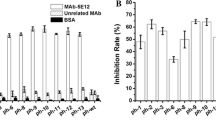Abstract
The envelope proteins of classical swine fever virus (CSFV) mediate the binding of CSFV to cell surface molecules and allow CSFV subsequent to enter host cells. However, the proteins binding to host cells and their binding sequences are uncertain. The results showed that the protein E1, E2, and Erns were displayed on the surfaces of T7 phages. The E2 and Erns phage clones showed high binding affinity to host cells, in which the E2 phage clone interacted more specifically with host cells than with other cells, while the Erns phage clone interacted with all tested cells. A 30-mer phage displaying peptide library was constructed and screened against immobilized host cells, in which each peptide was overlapped 10aa to another peptide and spanned all amino acid sequences of Erns and E2. Fifty-eight clones with specific binding to host cells were isolated. Amino acid sequence analyses for two phage clones (P2 and P6) demonstrated the strongest binding positions were at 101–130 (S2) in Erns, and 141–170 (S6) in E2, respectively. The synthetic peptides (S2 and S6) could inhibit the binding of phage clones (P2 and P6) and CSFV to cell. About 86.74 and 74.24% inhibition rates of CSFV infection were achieved at 55 μM of the synthetic peptides S2 and S6. The results also indicated that the S2 (LAEGPPVKECAVTCRYDKDADINVVTQARN) and S6 (AVSPTTLRTEVVKTFRRDKPFPHRMDCVTT) from CSFV were host cell binding peptides, and both of them had potential for research of CSFV entering host cells.






Similar content being viewed by others
References
K. Belák, F. Koenen, H. Vander hallen, C. Mittelholzer, F. Feliziani, G.M. De Mia et al., Comparative studies on the pathogenicity, tissue distribution of three virulence variants of classical swine fever virus, two field isolates, one vaccine strain with special regard to immunohistochemical investigations. Acta Vet. Scand. 50, 34–47 (2008)
Y. Junping, Y. Sheng, Z. Lina, G. Song, L. Xiufan, Multiplex PCR detection of main subsequent viruses in cases of high swine fever in Jiangsu Province from 2005 to 2006. Vet. Sci. Chin. 37, 1029–1034 (2007)
G. Meyers, T. Rumenapf, H.J. Thiel, Molecular cloning and nucleotide sequence of the genome of hog cholera virus. Virology 171, 555–567 (1989)
I. Greiser-Wilke, B. Zimmermann, J. Fritzemeier, G. Floegel, V. Moennig, Structure and presentation of a World Wide Web database of the CSF virus isolates held at the EU reference laboratory. Vet. Microbiol. 73, 131–136 (2000)
N. Ruggli, A. Summerfield, A.R. Fiebach, L. Guzylack-Piriou, O. Bauhofer, C.G. Lamm et al., Classical swine fever virus can remain virulent after specific elimination of the interferon regulatory factor 3-degrading function of Npro. J. Virol. 83, 817–829 (2009)
A. Gallei, S. Blome, S. Gilgenbach, N. Tautz, V. Moennig, P. Becher, Cytopathogenicity of classical swine fever virus correlates with attenuation in the natural host. J. Virol. 82, 9717–9729 (2008)
G. Meyers, H.J. Thiel, Molecular characterization of pestiviruses. Adv. Virus Res. 47, 53–118 (1996)
H.-J. Thiel, R. Stark, E. Weiland, T. Rumenapf, G. Meyers, Hog cholera virus molecular composition of virions from a pestivirus. J. Virol. 65, 4705–4712 (1991)
E. Weiland, R. Stark, B. Haas, T. Rumenapf, G. Meyers, H.J. Thiel, Pestivirus glycoprotein which induces neutralizing antibodies forms part of a disulfide-linked heterodimer. J. Virol. 64, 3563–3569 (1990)
E. Weiland, R. Ahl, R. Stark, F. Weiland, H.J. Thiel, A second envelope glycoprotein mediates neutralization of a pestivirus, hog cholera virus. J. Virol. 66, 3677–3682 (1992)
F. Weiland, E. Weiland, G. Unger, A. Saalmuller, H.J. Thiel, Localization of pestiviral envelope proteins Erns and E2 at the cell surface and on isolated particles. J. Gen. Virol. 80, 1157–1165 (1999)
M.M. Hulst, R.J. Moormann, Inhibition of pestivirus infection in cell culture by envelope proteins Erns and E2 of classical swine fever virus: Erns and E2 interact with different receptors. J. Gen. Virol. 78, 2779–2787 (1997)
Z. Wang, Y. Nie, P. Wang, M. Ding, H. Deng, Characterization of classical swine fever virus entry by using pseudotyped viruses: E1 and E2 are sufficient to mediate viral entry. Virology 330, 332–341 (2004)
C. Rhyner, M. Weichel, P. Hubner, G. Achatz, K. Blaser, R. Crameri, Phage display of human antibodies from a patient suffering from coeliac disease and selection of isotype-specific scFv against gliadin. Immunology 110, 269–274 (2003)
B. Zhang, Y. Zhang, J. Wang, J. Chen, Y. Pan, L. Ren et al., Screening and identification of a targeting peptide to hepatocarcinoma from a phage display peptide library. Mol. Med. 13, 246–254 (2007)
W. Xue, H.C. Minocha, Identification of the cell surface receptor for bovine viral diarrhoea virus by using anti-idiotypic antibodies. J. Gen. Virol. 74, 73–79 (1993)
F.B. Grieder, K.T. Schultz, Antiidiotypic antibody mimicry of a bluetongue virus neutralizing antigen. J. Immunol. 144, 2627–2631 (1990)
M.T.I. Nilsson, M.C. Mossing, M. Widersten, Functional expression and affinity selection of single-chain Cro by phage display: isolation of novel DNA-binding proteins. Protein Eng. 13, 519–526 (2000)
B. Ma, T. Elkayam, H. Wolfson, R. Nussinov, Protein–protein interactions: structurally conserved residues distinguish between binding sites and exposed protein surfaces. PANS 100, 5772–5777 (2003)
Y. Guohua, J. Qian, Z. Wang, Y. Qi, A phage-displayed peptide can inhibit infection by white spot syndrome virus of shrimp. J. Gen. Virol. 84, 2545–2553 (2003)
Acknowledgment
This study was supported by the National Natural Science Foundation of China (Grant No. 30571387).
Author information
Authors and Affiliations
Corresponding author
Rights and permissions
About this article
Cite this article
Li, X., Wang, L., Zhao, D. et al. Identification of host cell binding peptide from an overlapping peptide library for inhibition of classical swine fever virus infection. Virus Genes 43, 33–40 (2011). https://doi.org/10.1007/s11262-011-0595-7
Received:
Accepted:
Published:
Issue Date:
DOI: https://doi.org/10.1007/s11262-011-0595-7




